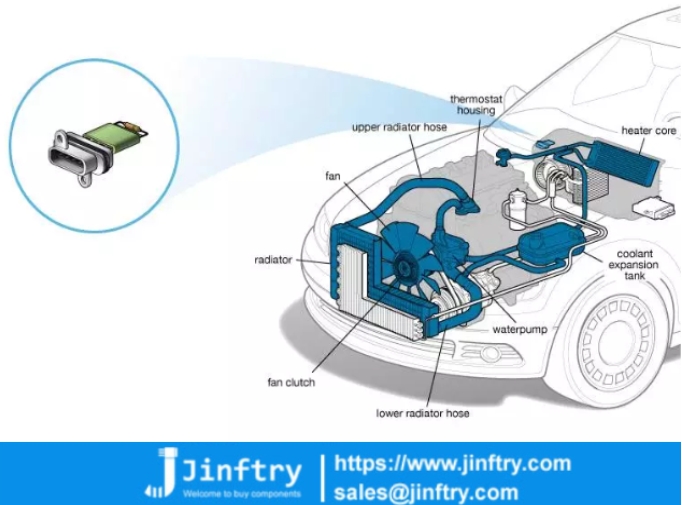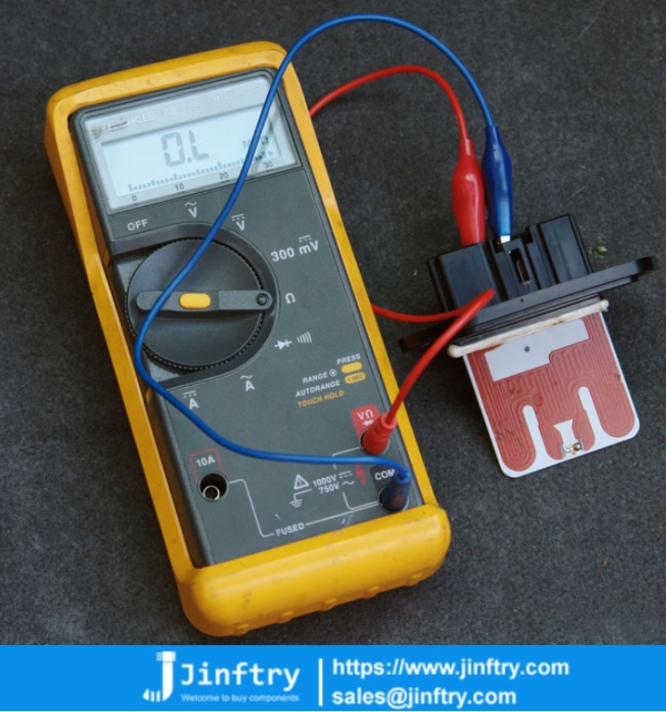How to Test Blower Motor Resistance?

Definition: Blower Resistor

Your car's heating, ventilation, and air conditioning system consists of many parts that work together to achieve the ideal air temperature inside the car. With luck, some of these parts should outlast the life of the car, but others will eventually wear out and need to be replaced.
A blower motor resistor is a small electrical component that, if it fails, can cause noticeable problems with the air in the passenger compartment. If you understand how it works, it will be easier to recognize the signs of a malfunctioning resistor.
What does a blower motor resistor do?

The speed of a vehicle's blower fan can be adjusted by adjusting the resistance of the blower motor, which is connected to the fan switch. Air conditioning can adjust the fan speed mechanically (using a rotating lever) or electrically by changing the resistance of the blower resistor.
The blower motor resistor determines the speed of the fan. This used to be accomplished by adjusting the power supplied to the fan motor. Today, most applications use solid-state modules rather than conventional resistors to control the speed of the blower motor.
The conventional resistor for the blower motor is connected in series with the engine and to ground. Blower motor resistors are available in a variety of strengths. The current through the fan motor is regulated by this. One or more resistors of the blower resistor assembly are connected to each fan speed setting.
The maximum speed of the blower motor is adjusted by varying the resistance to current. When maximum acceleration is required, the blower motor resistor-to-ground circuit is temporarily disconnected and the blower motor ground terminal is connected to ground. Maximum power can then be sent to the fan motor.
Blower Motor Resistor Location

It is located underneath the blower motor. The glove box of some vehicles may need to be removed to access the blower motor resistor.
Symptoms of a Bad Blower Motor Resistor
If the blower motor resistor fails, the functionality of the entire air conditioning system may be affected. In most cases, a blower motor resistor failure will result in some indications that will alert the driver to a possible problem.It is important to be fully aware of the signs that indicate a bad motor resistor.
1. Blower Motor Only Runs at One Speed
A bad blower motor resistor often manifests itself as a blower motor that is permanently set to one of its settings. The resistor in the blower motor is a key component in regulating the fan speed. If the resistor is shorted or damaged for some reason, the blower motor may become stuck on a single fan speed.
The air conditioning and heating system may keep running at the same speed, but the resistor must be replaced before the system can resume its full functionality.
2. Blower Motor Resistor Does Not Turn On
Another classic sign of a bad blower motor resistor is that the motor will not operate under certain conditions. If a component of the blower motor resistor fails, the blower motor resistor may fail or stop working completely at one or more of the available settings.
If you are still determining what the problem is, you should get a proper diagnosis as soon as possible, as a bad blower motor switch could be the cause of your woes.
3. Your car's vents aren't producing any airflow at all
No air coming out of your car's vents is also another sign of a bad blower motor resistor. The blower motor resistor is connected to the power source, so if the resistor fails or any other problem occurs, the power to the blower motor can be shut off.
Let’s say the power source to the blower motor fails. In this case, the blower motor will not be able to generate any air pressure, causing the air conditioning and heating system to not be able to blow any air out of the vents. A failure in the blower motor resistor that provides power to the motor can cause serious problems for the motor and the HVAC system.
If your vehicle is experiencing any of the symptoms listed above, or you have any reason to believe that the blower resistor is not performing properly, you should have it inspected by a trained professional to determine if the part must be replaced.
How to Test the Blower Motor Resistor
1. Locate the Blower Motor Resistor FuseIn order to repair your car’s blower motor resistor fuse, you must first locate it.
2. Always Check the Resistor Fuse
Locating the blower motor resistor fuse is the first step to ensure that it is functioning properly. Use a 12 V test light with one end connected to ground and the other to the fuse terminals.
Make sure the fuse is functioning properly by observing the current flow between the terminals. To know if the fuse is working properly, check to see if current is flowing to both terminals. However, if the fuse is de-energized, they are burned out and need to be replaced.
3. Remove and Test the Blower Motor Resistor

Disconnect power to the blower motor and connect it to a 12 V test light. Testing in this manner will eliminate any potential errors caused by the car's electronic temperature control system.
Varying the speed of the blower motor during activity can help you determine if the problem is occurring at a specific airflow rate. A blower motor failure is obvious because it loses power when running at high speeds.
Remember that the blower motor gets power from the switch at a specific high speed, so if you set the motor to a faster speed and find that there is no power, the problem may be related to a faulty switch. If the blower motor runs fine at high speeds but not at low speeds, the problem may be related to the blower motor resistor.
4. Check the Blower Motor's Ground
The body is the ground for the blower motor; if the ground is damaged, the motor will not work. A worn bullet may cause intermittent blower motor failure. If none of the other tests above reveal a problem with the resistor, you should check the blower motor ground wire.
How to Replace a Blower Motor Resistor
Here are the basic steps to replace a blower motor resistor:- 1. The blower motor resistor must be located
- 2. Pull the blower motor resistor
The screws must be tightened with a ratchet with a small extension bar. After removing the bolts, the last step is to pull out the blower resistor.
- 3. Disconnect the wires
- 4. Set up the new blower resistor
If you have removed the resistor from the blower motor, you should put it back in place. Install new screws to ensure they are secure in place. Once you have completed the task, connect the pigtail. Unfortunately, in some cases, the pigtail may not be repairable. If this is the case, proceed to the next section.
We need to cut the old cable and reattach the new one. This should be easy to figure out, as the cables should be color-coded. Use the plug to connect the new cables together. Simply put the pigtail back in place.
Conclusion
The blower motor resistor may be a small component of the HVAC system, but it still plays a vital role. Since it determines the speed at which the blower motor fan rotates, the blower motor resistor is the most vulnerable part of the device.When a resistor in your blower motor fails, it should be replaced immediately. Otherwise, you may find yourself without proper heating and cooling. When a blower motor resistor fails, it should be repaired immediately. However, if your car has other, more serious problems with its engine or transmission, it may not be worth the money to try to repair the blower motor resistor.
Statement
All articles (images, texts, audio) on this site are uploaded and shared by users, or integrated from relevant internet sources, only for user's learning. If your rights are violated, please contact the administrator to delete! Link to this article: https://www.jinftry.com







